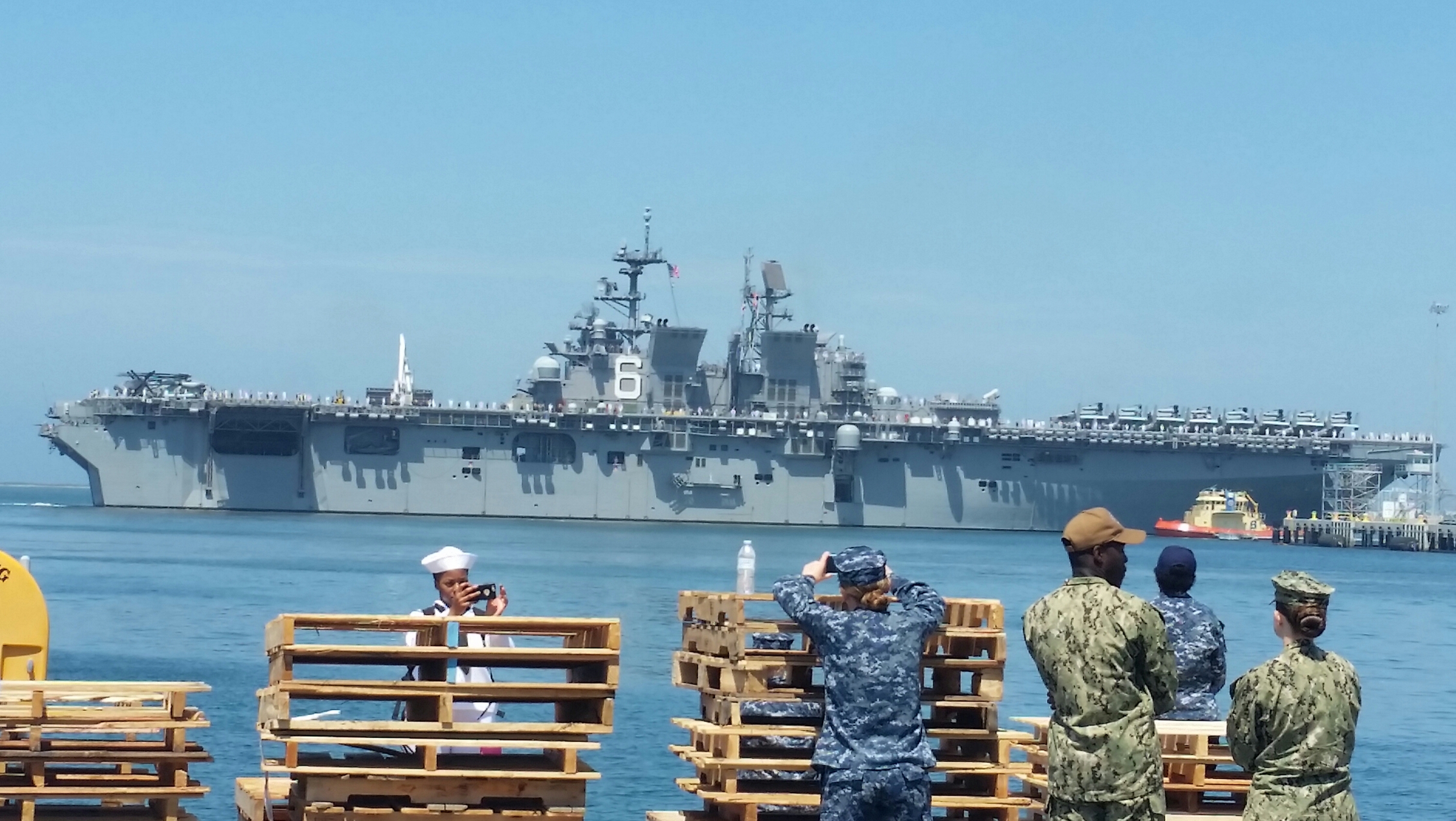
NAVAL BASE SAN DIEGO, Calif. – Nudged by several orange-and-tan tugs, amphibious assault ship USS America (LHA-6) pushed away from Pier 13 and spun into San Diego Bay to start its first operational deployment Friday to the Western Pacific and Middle East regions.
A subdued crowd of several dozen remained along the metal fence line along the pier side road to watch as the final sets of lines were brought in for the mid-morning departure. Two hours earlier, a larger crowd of spouses, children, parents and friends had said their final good-byes to their sailors inside America before the ship’s horn sounded the departure.
Guillermo Diaz, a retired Navy personnel specialist, snapped a photo of America through the fence as it began to pull away. He texted it to his son, Operations Specialist Francisco Diaz, who was making his second deployment in two years and is now assigned to the commodore’s staff. “He saw me off for two cruises, so now we’re even,” said the senior Diaz, who works at the Fleet Anti-Submarine Warfare Training Center in San Diego.
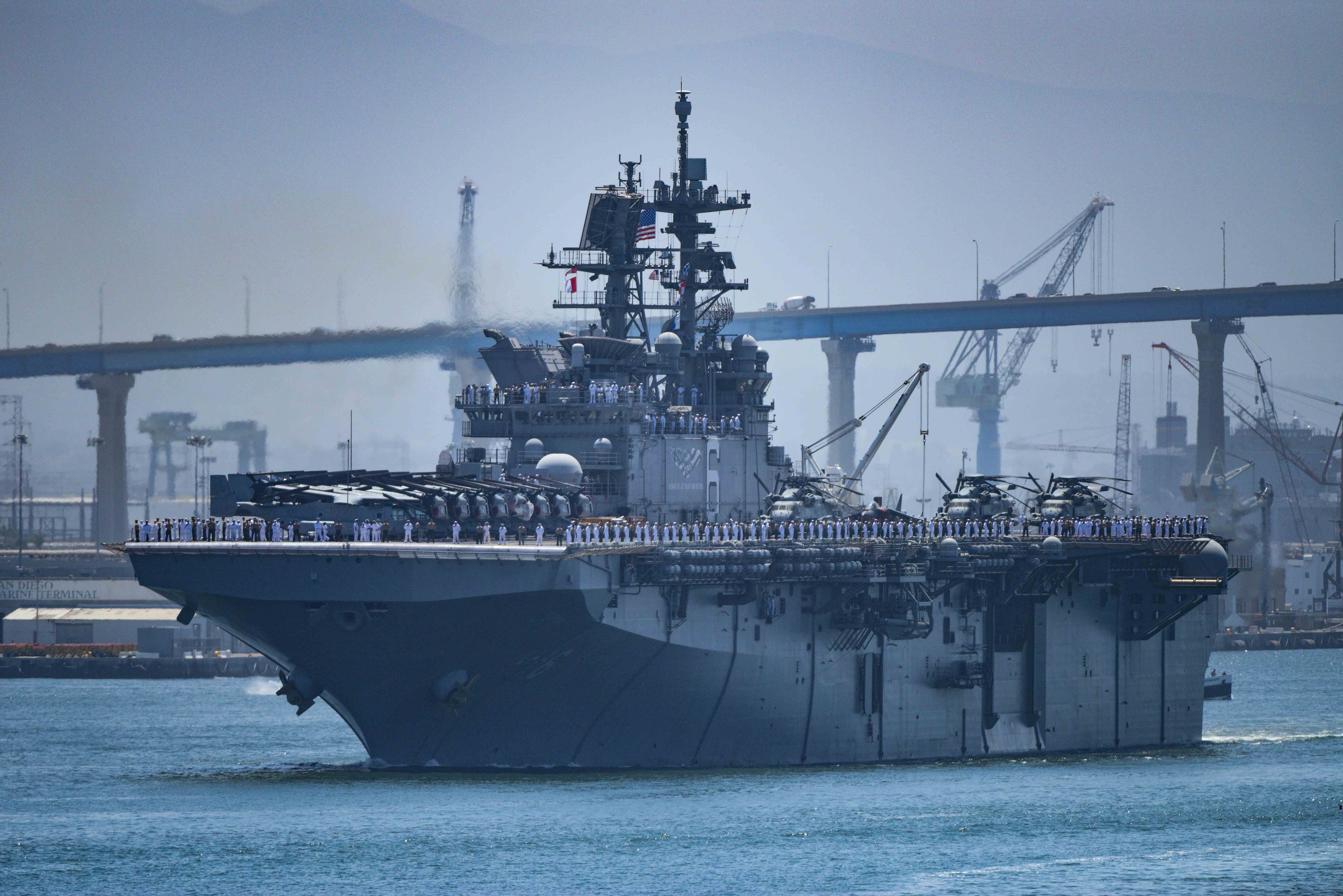
OS2 (SW) Ajani Pittman, who’s assigned to the guided-missile cruiser USS Lake Champlain (CG-57), joined him to see off Francisco, his friend, as well as Pittman’s girlfriend, OS2 Kira Schultz, who was making her first overseas deployment. “Try to enjoy it, and do all the things you can do to get advanced (in rank),” Pittman had offered as advice to her. “As long as you stay positive, it’s going to go by very quickly.”
The big-deck amphibious ship is the flagship for the 4,500-member, three-ship America Amphibious Ready Group, comprised of Amphibious Squadron 15, amphibious transport dock USS San Diego (LPD-22), dock landing ship USS Pearl Harbor (LSD-52) and the 15th Marine Expeditionary Unit.
“We are well-trained, well-equipped, well-informed, and we are ready for any sort of military operations that may come our way,” Col. Joseph R. Clearfield, who commands the Camp Pendleton, Calif.-based 15th MEU, said in brief remarks to reporters on the pier.
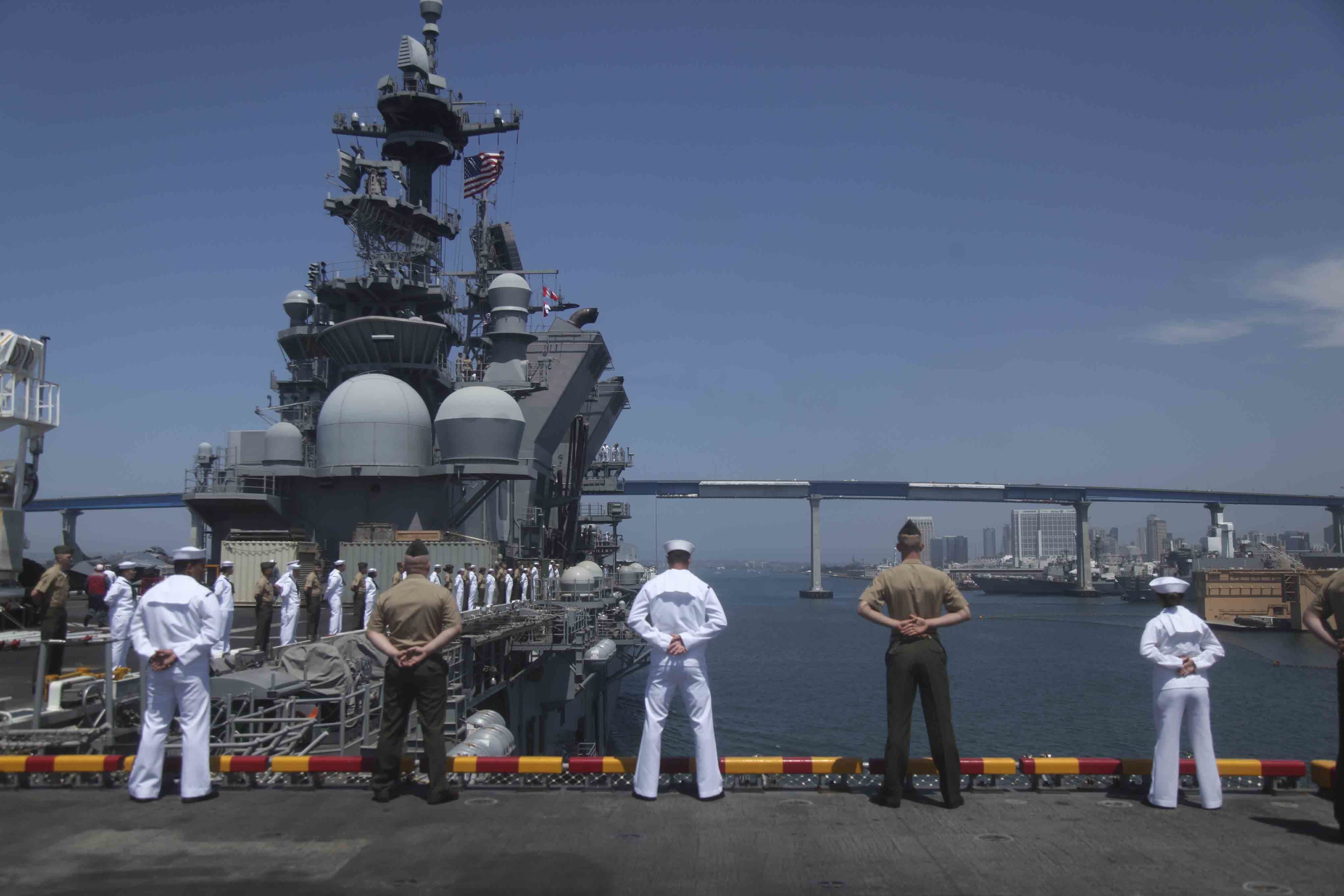
“Nobody promised anyone that this would be easy, but what we did promise them was that it would be worth it,” Clearfield said. “We are going to be a part of something that every Marine and sailor and their loved ones and their family members can be very proud of when we look back at this at about this time next year.”
The deployment is considered “standard” for a West Coast-based ARG/MEU deployment, notwithstanding unexpected missions or contingencies that can arise whenever blue-green forces go overseas. “We’ll pass through the (U.S. Pacific Command area of responsibility). We are intending to spend some time in the (U.S. Central Command) AOR,” said Clearfield. “But anything can change, because we are a global response force, ready to respond to the president and the secretary of defense as he needs us.”
The scheduled deployment marks America’s first with a fully-embarked, 2,500-member Marine expeditionary unit.
“The first one is always a big one, so it always feels great,” Navy Capt. Joseph Olson, America’s commanding officer, said before boarding the ship. “For the Sailors and the Marines aboard, it’s going to be a great deployment, going out to sea and doing our jobs.”
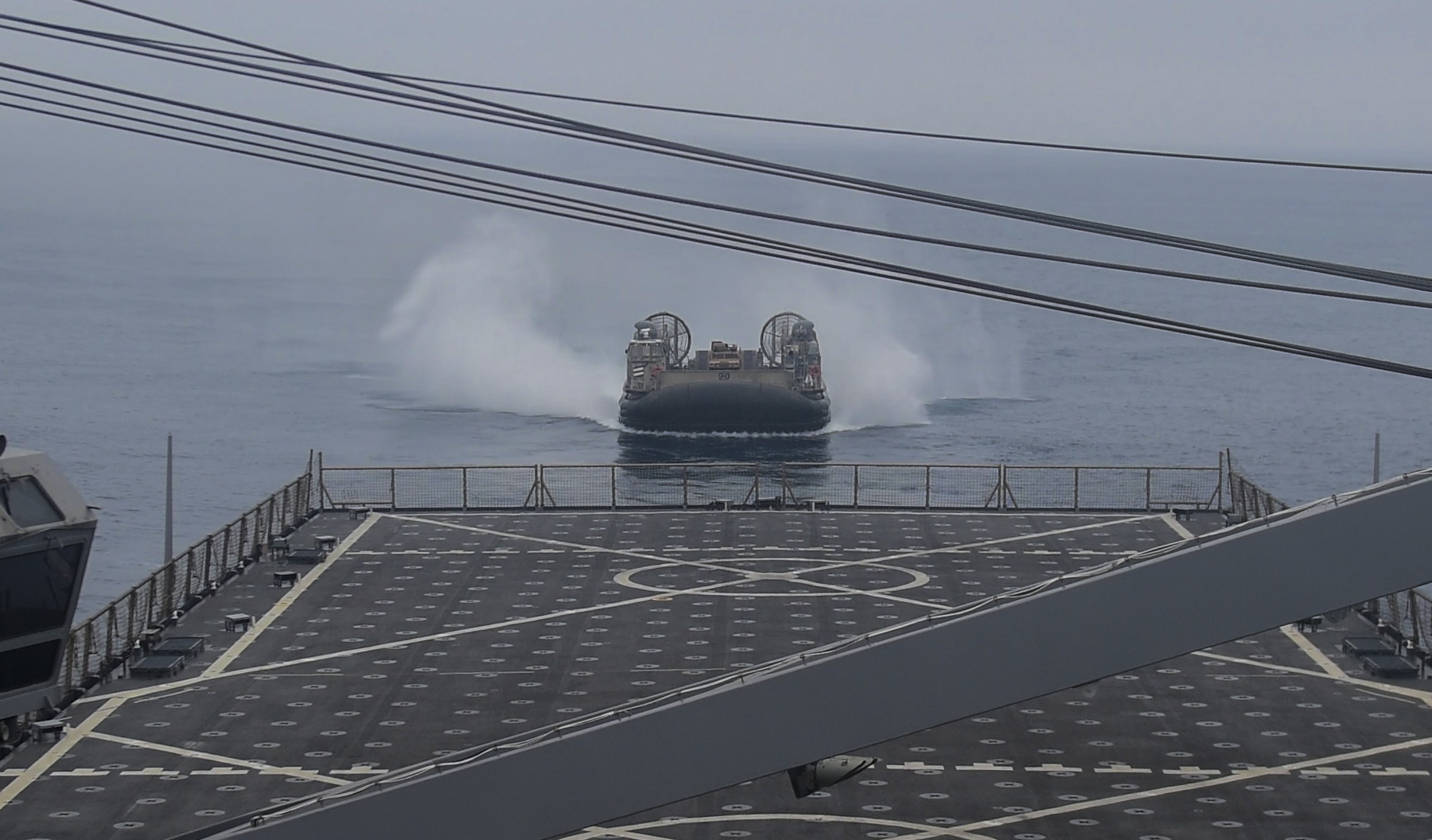
“We’re prepared and we’re ready to go. I’m excited and ready to work with them,” Olson added. America’s unique design swaps out a well deck to accommodate landing craft with more aviation spaces for maintenance, repair and storage, expanded fuel storage to support a more-robust air support capability and more advanced command and control systems. America is the first of what will be two ships with this air-centric configuration, crafted in mind with the long-range capabilities of the Marine Corps’ newest F-35B Lightning II fifth-generation, multi-mission jet as well as the MV-22 Osprey tiltrotor aircraft.
The ship is optimized for long-range aviation operations, a difference with the existing Wasp LHD class of big-deck/well deck-equipped amphibs, officials say. Just how that will work out throughout the deployment remains to be seen, and it will be well-studied. “We see that sort of as one of our institutional (tasks), as we get back, is how this ship can operate like a Lightning carrier and how we can maximize its use,” Clearfield said.
This year so far has been busy for the 15th MEU and the America ARG as they kicked predeployment training into high gear through three major blue-green, at-sea periods: the PHIBRON/MEU Integration Exercise, or PMINT; Composite Training Unit Exercise (COMPTUEX) and the final Certification Exercise (CERTEX). Training missions ran the gamut of military operations, from low-end missions to full-on combat scenarios, and challenged them in various warfare areas including cyber operations. “We’ll be able to strike the enemy hard, if that’s what our nation needs us to do,” Clearfield said.
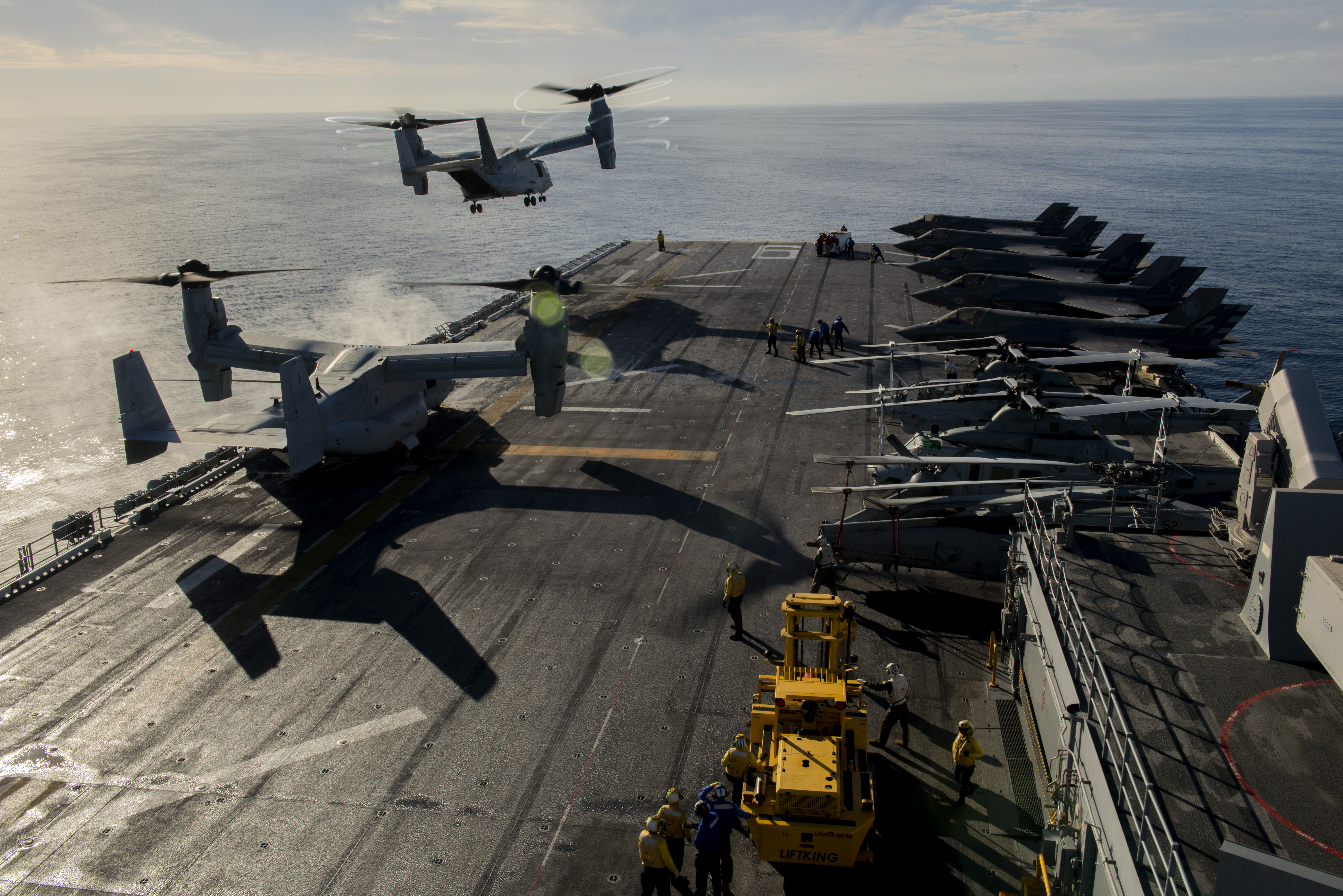
The workups in the field and at sea were intense and challenging as Marines faced off against very formidable opponents, by design. “The days of uncontested operations for us are long gone,” Clearfield noted, “so we’re prepared to be contested in every environment, with cyber probably one that we’re most challenged” since some adversaries have quite robust capabilities.
America had arrived in San Diego in September 2014 after a maiden voyage from its Pascagoula, Miss., shipyard and through South America with a special-purpose Marine air-ground task force. The ship was commissioned in San Francisco on Oct. 11, 2014, and later went into the shipyard for additional upgrades and work ahead of its short deployment for the Rim-of-the-Pacific exercises in 2016. America also served as a test-bed for F-35B development testing last fall.

“It’s a long haul from commissioning of the ship and then you go into a large availability,” Olson said. “We’ve worked very hard over the last two years to make this ship deploy and then train on top of that. The crew has done a fantastic job. I’m just excited for them.”
Along the pier, a trio of women watched America depart, already missing Aviation Boatswain’s Mate (Handling) Gina Cisneros, a member of the crash-fire crew. Her mother, Stacy Cisneros, her grandmother, Hilda Valencia, and her wife, Mary Cisneros, held back tears. They were pierside when America first arrived in San Diego and when the ship was commissioned, all days of big joy. But deployment day, even with so much planning, was tough.
Today “is a little different, because she’s going to the Middle East. You never know what’s going to happen,” said Stacy Cisneros, whose youngest daughter, Dana Cisneros, is also in the Navy and recently assigned in Norfolk as a master-at-arms.
“I’m just going to miss her,” Mary Cisneros said, crying briefly as her mother-in-law hugged her tightly. They’ve been married almost three years and endured the separations of workups, but it’s never easy. “I didn’t think I would cry,” she said. “I was holding it in since last night.”
The women arrived at the base Friday morning but couldn’t give Gina Cisneros, already aboard, a final hug and kiss. “We didn’t get to see her today at all,” Hilda Cisneros said. But their thoughts shifted to care packages to mail, calls to make and emails to send her in the coming weeks and months. Stacy Cisneros added: “I told her to think positive and have fun.”
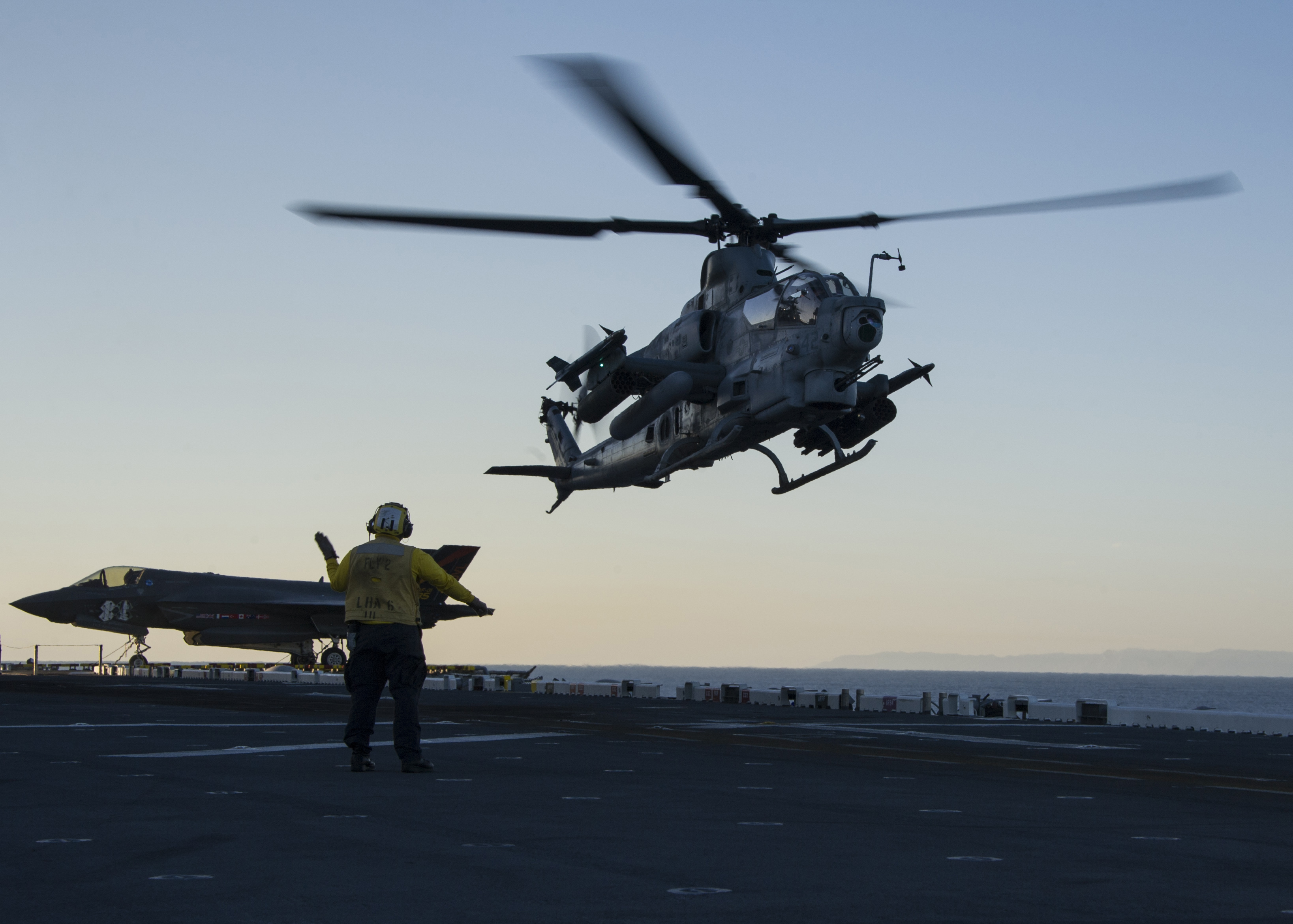
Navy Capt. Rome Ruiz, the commodore and PHIBRON 3 commander, praised the work of the blue-green team to “come together as a highly capable, lethal force.”
“They spearheaded an environment of innovation and dominated the battle space in the training phases by leveraging the unique characteristics of the America ARG as an up-gunned, aviation-centric task force,” Ruiz said in a Third Fleet statement.
PHIBRON 3 includes the America, San Diego and Pearl Harbor; Helicopter Sea Squadron 23; and detachments from Naval Beach Group 1, Assault Craft Unit 5, Beachmaster Unit 1, Fleet Surgical Team 1 and Tactical Air Control Squadron 11, according to Third Fleet. The 15th MEU includes an air combat element led by Marine Medium Tiltrotor Squadron 161 (Reinforced); a ground combat element led by Battalion Landing Team 1st Battalion, 5th Marines; and Combat Logistics Battalion 15.





